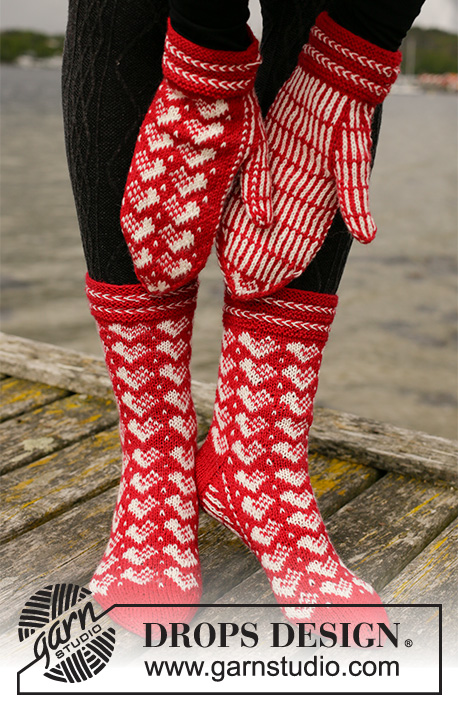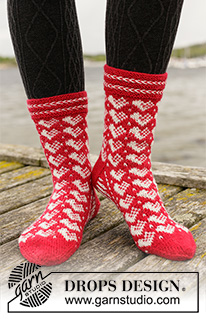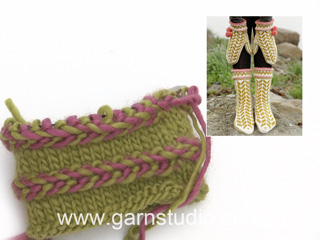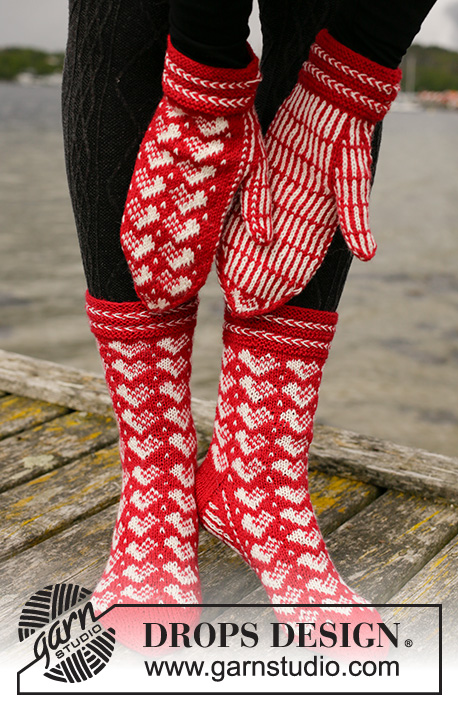Holiday Hearts |
|||||||||||||||||||
 |
 |
||||||||||||||||||
Knitted socks with hearts in DROPS Fabel. The piece is worked top down with Latvian cables and Nordic pattern. Sizes 35 - 43. Theme: Christmas.
DROPS Extra 0-1464 |
|||||||||||||||||||
|
------------------------------------------------------- EXPLANATIONS FOR THE PATTERN: ------------------------------------------------------- PATTERN: See diagrams A.1 to A.4. LATVIAN CABLE: The cable consists of 3 rounds – all the rounds are included in A.1 and marked A.x. The 3 rounds are worked as follows: ROUND 1: * Knit 1 using red, knit 1 using off-white *, work from *-* to end of round. ROUND 2: Bring both strands to the front of the piece (towards you). Take the red strand to the back, purl 1 and bring the strand to the front. Take the off-white strand under the red strand and then to the back of the piece, purl 1 and bring the strand to the front. Continue like this, purling alternately with red and off-white, but always take the strand UNDER the strand from the last stitch worked. ROUND 3: Work as round 2, but now always take the strand OVER the strand from the last stitch worked. DECREASE TIP (evenly spaced): To work out how to decrease evenly, count the total number of stitches on the needles (e.g. 64 stitches) and divide by number of decreases to be made (e.g. 4) = 16. In this example decrease by knitting each 15th and 16th stitch together. KNITTING TIP-1: To avoid the knitting tension becoming tighter when working pattern it is important that the strands at the back are not tight. Use a half-size larger needle when working pattern if this is a problem. KNITTING TIP-2 (for heel): To strengthen the heel you can work with 2 strands when working the heel and heel decrease as follows: Use the strand from both the inside and outside of the ball and work 1 stitch alternately with first the one then the other strand; this gives you a slightly thicker heel without using a double strand. HEEL DECREASE: ROW 1 (= right side): Knit until there are 8-8-9 stitches left, slip the next stitch as if to knit, knit 1 and pass the slipped stitch over the knitted stitch, turn the piece. ROW 2 (= wrong side): Purl until there are 8-8-9 stitches left, slip the next stitch as if to purl, purl 1 and pass the slipped stitch over the purled stitch, turn the piece. ROW 3 (= right side): Knit until there are 7-7-8 stitches left, slip the next stitch as if to knit, knit 1 and pass the slipped stitch over the knitted stitch, turn the piece. ROW 4 (= wrong side): Purl until there are 7-7-8 stitches left, slip the next stitch as if to purl, purl 1 and pass the slipped stitch over the purled stitch, turn the piece. Continue to decrease in this way by working 1 less stitch before slipping a stitch and until there are 15-15-17 stitches left on the row. ------------------------------------------------------- START THE PIECE HERE: ------------------------------------------------------- SOCK – SHORT OVERVIEW OF THE PIECE: The piece is worked in the round with double pointed needles, top down. SOCK: Read KNITTING TIP-1! Cast on 64-64-74 stitches with double pointed needles size 2.5 mm and red. Work A.1 in the round. When A.1 has been completed in height, knit 1 round with red where you decrease 4 stitches evenly spaced – read DECREASE TIP = 60-60-70 stitches. The next round is worked as follows: Sizes 35/37 and 38/40: Work A.2A (= 4 stitches), A.2B over the next 50 stitches (= 5 repeats of 10 stitches) and A.2C (= 6 stitches). Size 41/43: Work A.2B over all 70 stitches (= 7 repeats of 10 stitches). ALL SIZES: Continue this pattern (make note, you always knit 1 round of red over all stitches after a row of hearts). REMEMBER THE KNITTING TENSION! Repeat A.2 a total of 4-5-5 times in height but finish when you still have 1 round of red over all stitches left. The piece now measures approx. 13-16-16 cm from the cast-on edge. Now work the heel as described below: Keep the first 14-14-17 stitches on the needle for the heel, place the next 31-31-37 stitches on 1 thread without working them (= mid-top of foot) and keep the last 15-15-16 stitches on the needle for heel = 29-29-33 stitches on the needle for heel. Read KNITTING TIP-2 and work stocking stitch using red, back and forth over the heel stitches for 5-5½-6 cm. Insert 1 marker in the middle of the last row; this will be used to measure the foot length later. Work the HEEL DECREASE with red – read description above. After the heel decrease work the next round with red as follows: Knit the 15-15-17 heel stitches, knit up 13-14-16 stitches along the side of the heel, knit the 31-31-37 stitches from the thread and knit up 13-14-16 stitches along the other side of the heel = 72-74-86 stitches on the round. Continue to the middle of the heel; the round now begins from here. Insert 1 marker on each side of the middle 41 stitches on top of foot (i.e. on each side of A.4). There are 31-33-45 stitches under the foot. Insert 1 marker thread mid-under foot so there are 15-17-23 stitches after the marker thread (i.e. to the left of the marker thread) and 16-16-22 stitches before the marker thread (i.e. to the right of the marker thread). Start the round at the marker thread (= mid-under foot) and work the first round as follows: Work A.3A over the first 14-16-22 stitches (= 7-8-11 repeats of 2 stitches), A.3B (= 1 stitch), A.4 (= 41 stitches) and A.3A over the next 16-16-22 stitches (= 8-8-11 repeats of 2 stitches). Continue this pattern. When you have worked 2 full rounds, decrease on each side of the middle 39 stitches on top of foot as follows (decreases always worked using red): Decrease as follows at the first marker: Work until there is 1 stitch left before the marker, knit this stitch together with the first stitch after the marker (= last stitch in A.3 knitted together with first stitch in A.4). Decrease as follows at the second marker: Work until there is 1 stitch left before the marker, knit this stitch twisted together with the first stitch after the marker (= last stitch in A.4 knitted twisted together with first stitch in A.3). Decrease like this every 2nd round a total of 8-8-12 times = 56-58-62 stitches left (A.4 is always worked over the 41 stitches on top of foot, but there will be fewer and fewer stitches in A.3 under the foot). Continue working without further decreases until the piece measures 18-19-21 cm from the marker on the heel, finishing after a complete row of hearts. Then work stocking stitch with red to finished length. When the piece measures 18-19-21 cm from the marker on the heel, there is approx. 4-5-6 cm left to finished length; you can try the sock on and work to desired length. Insert 1 marker on each side of the sock so there are 28-29-31 stitches both on top of and under the foot. Work stocking stitch with red and decrease to toe on each side of both markers as follows: 3 stitches before the marker thread, knit 2 together, knit 2 (the marker thread sits between these 2 stitches) and knit 2 twisted together. Repeat this decrease at the other marker (= 4 stitches decreased on the round). Decrease every 2nd round a total of 3-5-7 times and then every round a total of 8-7-6 times = 12-10-10 stitches. On the next round knit all stitches together 2 and 2 = 6-5-5 stitches. Cut the strand and pull it through the remaining stitches, tighten and fasten well. The sock measures approx. 22-24-27 cm from the marker on the heel. Work 1 more sock in the same way. |
|||||||||||||||||||
Diagram explanations |
|||||||||||||||||||
|
|||||||||||||||||||

|
|||||||||||||||||||

|
|||||||||||||||||||
|
Have you made this or any other of our designs? Tag your pictures in social media with #dropsdesign so we can see them! Do you need help with this pattern?You'll find tutorial videos, a Comments/Questions area and more by visiting the pattern on garnstudio.com. © 1982-2024 DROPS Design A/S. We reserve all rights. This document, including all its sub-sections, has copyrights. Read more about what you can do with our patterns at the bottom of each pattern on our site. |
|||||||||||||||||||




























































Comments / Questions (6)
Thank you for this lovely pattern! I've adapted it to knit a Christmas stocking for myself using DK wool - I added a band with my initials between the two cables and adjusted the proportions of the heel and foot. It turned out beautifully! I'm now casting on another stocking for my son with snowflake motifs instead of hearts.
03.09.2021 - 12:06Buongiorno. Non riesco a capire il suggerimento per il tallone rinforzato. Cosa significa lavorare una maglia in modo alternato con un capo dall'interno e dall'esterno del gimitolo? Cosa devo fare esattamente? Grazie mille.
23.11.2020 - 15:35DROPS Design answered:
Buonasera Maria, deve lavorare il tallone con entrambi i capi del gomitolo, quindi sia quello interno che quello esterno. Deve lavorare una maglia con un capo e una maglia con l'altro capo. Buon lavoro!
23.11.2020 - 21:53🌹Er det på nogen måde muligt at i laver et katalog udelukkende med strømper med mønster og sokker og futter 🌹
20.05.2020 - 11:05DROPS Design answered:
Hei Anni. Vi har sluttet med kataloger med oppskrifter, kun brosjyrer med bilder. Vi legger ut alle våre oppskrifter gratis på vår nettside og her kan du enkelt søke på f.eks strømper. mvh DROPS design
25.05.2020 - 14:25Bonjour, il me semble qu'il manque les diagrammes A1 et A3 car ils sont cités dans les explications mais n'apparaissent pas dans la partie diagrammes. Merci pour votre réponse.
07.12.2019 - 10:53DROPS Design answered:
Bonjour Catherine, effectivement, merci pour votre retour, nous allons faire le nécessaire le plus rapidement possible. Bon tricot!
09.12.2019 - 08:18Bonjour, je ne vois pas le sigle de la tresse lettone A.x sur les diagrammes ? Merci pour la réponse ..
07.12.2019 - 07:56Hallo, es fehlen die Anleitung A1 und A3 sowie die Angabe, wie breit A1 ausgeführt werden sollte - oder habe ich es einfach überlesen?
07.12.2019 - 06:41DROPS Design answered:
Liebe Rena, Sie sind ja rechts, die felhende Diagramme hochladen wir so schnell wie möglich, Danke für den Hinweis, Viel Spaß beim stricken!
09.12.2019 - 08:06